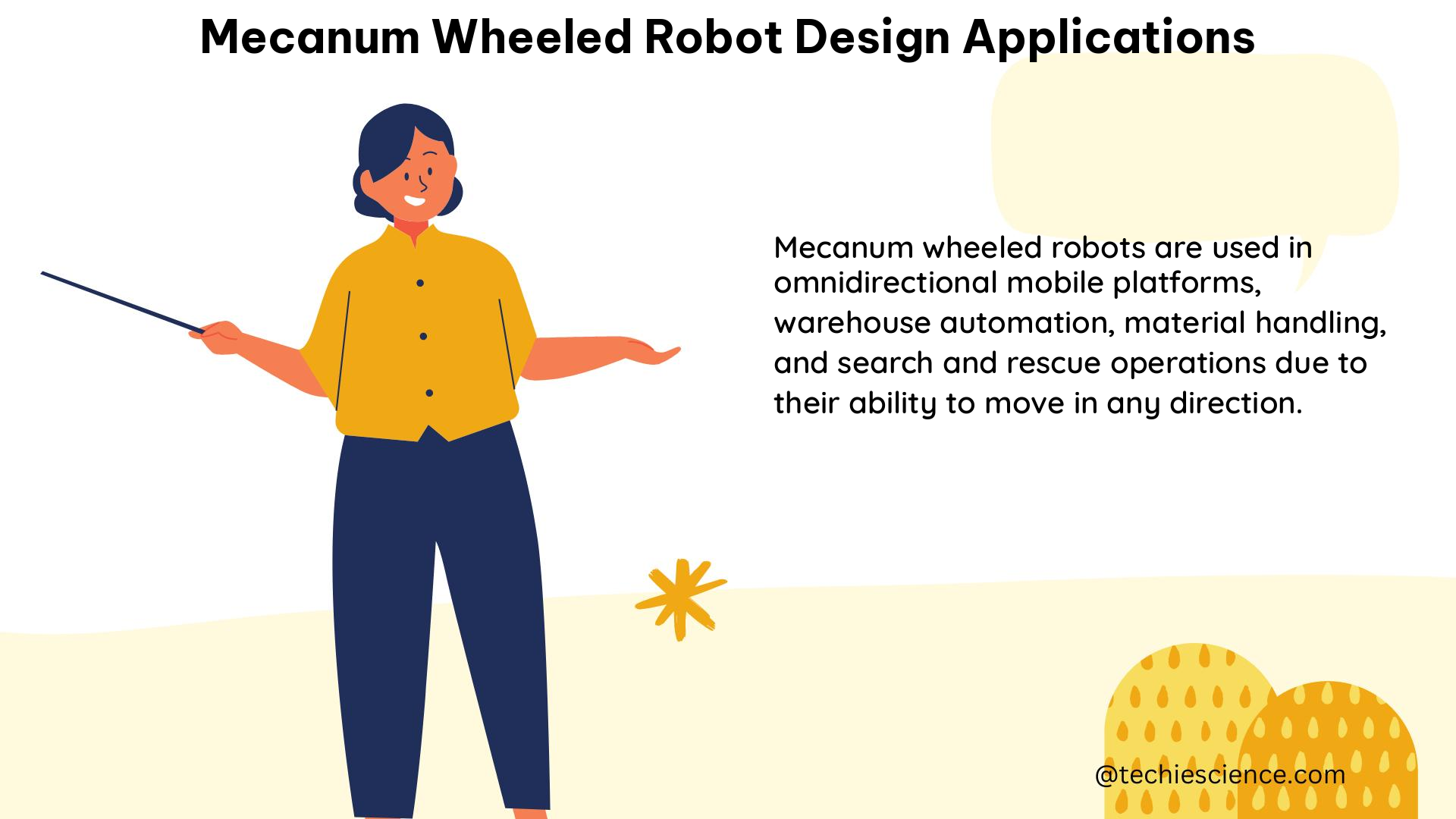Mecanum wheeled robots are omnidirectional mobile platforms that offer unparalleled maneuverability and precise control, making them invaluable in a wide range of applications, from material handling and transportation to inspection and research. This comprehensive guide delves into the technical specifications, design considerations, and practical applications of these versatile robotic systems, equipping you with the knowledge and insights to harness their full potential.
Technical Specifications of Mecanum Wheeled Robots
Manufacturing Complexity
Mecanum wheels are more intricate to manufacture compared to conventional wheels due to their unique roller design. This complexity is reflected in the production process, which requires meticulous precision and careful assembly to ensure optimal performance.
The rollers on a mecanum wheel are typically made of a durable material, such as polyurethane, and are mounted on the wheel at a 45-degree angle. This angled arrangement allows the rollers to interact with the ground in a specific pattern, enabling the robot to move in any direction. The manufacturing process involves aligning the rollers with high accuracy, as even minor deviations can impact the robot’s maneuverability and control.
Load Capacity
One of the trade-offs of the mecanum wheel design is a lower load capacity compared to conventional wheels. This is because the rollers on the wheels distribute the load over a larger area, reducing the overall load-bearing capacity. The specific load capacity of a mecanum wheeled robot depends on factors such as the wheel size, material, and the number of wheels used.
To address this limitation, designers may opt for larger wheel diameters or incorporate additional wheels to increase the overall load capacity. Additionally, the robot’s frame and structural components must be designed to support the anticipated loads without compromising the system’s mobility and agility.
Sensitivity to Rough Surfaces
Mecanum wheels are more sensitive to rough or uneven surfaces due to the increased contact area between the rollers and the ground. This sensitivity can lead to reduced performance and accuracy on surfaces with significant irregularities, such as cracks, potholes, or debris.
To mitigate the impact of rough surfaces, designers may consider incorporating suspension systems or larger wheel diameters to maintain stability and control. Additionally, the robot’s control algorithms may need to be optimized to account for the increased sensitivity and provide smooth, precise movements even in challenging environments.
Minimum Number of Wheels Required
Mecanum wheeled robots typically require a minimum of four wheels to achieve omnidirectional movement. This is due to the need for rollers on each wheel to interact with the ground in a specific pattern, allowing the robot to move in any direction.
The arrangement of the four wheels is crucial, as they must be positioned in a specific configuration to enable the desired range of motion. Typically, the wheels are arranged in a square or rectangular pattern, with the rollers on each wheel oriented at a 45-degree angle to the robot’s frame.
Degrees of Freedom (DoFs)
Mecanum wheels provide three degrees of freedom, allowing the robot to move in any direction (forward, backward, and sideways) and rotate around its vertical axis. This is in contrast to conventional wheels, which typically provide only one degree of freedom (forward and backward movement).
The three degrees of freedom offered by mecanum wheels are:
1. Translational Motion: The robot can move in any direction (forward, backward, and sideways) by varying the speed and direction of the individual wheels.
2. Rotational Motion: The robot can rotate around its vertical axis by varying the speed and direction of the wheels on opposite sides of the robot.
3. Combination of Translational and Rotational Motion: The robot can perform a combination of translational and rotational movements, allowing for precise and complex maneuvers.
Steering
Mecanum wheeled robots can be steered by varying the motor speed and spinning direction of the individual wheels. This allows for precise control and high maneuverability, as the robot can change direction and orientation without the need for a traditional steering mechanism.
The control algorithms for mecanum wheeled robots must be designed to coordinate the speed and direction of the individual wheels to achieve the desired movement. This requires a deep understanding of the wheel’s kinematics and the robot’s overall dynamics.
Programming
Controlling the movement of a mecanum wheeled robot requires specialized programming to account for the unique mechanics of the wheels. The control algorithms must consider factors such as wheel speed, spinning direction, and the interaction between the rollers and the ground to achieve accurate and responsive movements.
Programmers working with mecanum wheeled robots often utilize advanced control techniques, such as closed-loop feedback control, to ensure precise and stable operation. Additionally, the control software may need to be optimized for specific applications, taking into account factors like payload, environmental conditions, and desired performance characteristics.
Practical Applications of Mecanum Wheeled Robots

Mecanum wheeled robots have found widespread applications in various industries and research fields due to their exceptional maneuverability and versatility. Some of the key application areas include:
Material Handling and Logistics
Mecanum wheeled robots are well-suited for material handling and logistics applications, such as automated guided vehicles (AGVs) and warehouse automation systems. Their ability to move in any direction and rotate on the spot allows them to navigate tight spaces, perform precise positioning, and efficiently transport goods and materials within a facility.
These robots can be equipped with grippers, lifts, or other material handling attachments to streamline the movement and organization of inventory, reducing labor costs and improving overall productivity.
Transportation and Inspection
Mecanum wheeled robots are often employed in transportation and inspection tasks, particularly in environments where high mobility and precise control are essential. They can be used for autonomous or semi-autonomous transportation of people or goods, as well as for inspection and monitoring applications in industrial settings, construction sites, or hazardous environments.
The omnidirectional movement capabilities of mecanum wheeled robots enable them to navigate through narrow corridors, around obstacles, and in confined spaces, making them ideal for tasks that require access to hard-to-reach areas.
Research and Experimentation
In the field of research and experimentation, mecanum wheeled robots have become valuable tools for scientists and engineers. Their versatility and precise control allow them to be used in a wide range of applications, such as:
- Robotic platforms for testing and evaluating new control algorithms or sensor technologies
- Testbeds for studying multi-agent coordination and swarm robotics
- Platforms for developing and testing autonomous navigation and mapping algorithms
- Assistive robots for human-robot interaction studies
- Exploration and reconnaissance in challenging environments
The ability to easily maneuver and adapt to different research scenarios makes mecanum wheeled robots a popular choice for various experimental and prototyping purposes.
DIY Mecanum Wheeled Robot Project
Building a DIY mecanum wheeled robot can be a rewarding and educational experience for hobbyists, students, and makers. Here’s a step-by-step guide to help you get started:
Components
- Wemos mini D1 (or compatible ESP32 board)
- Four 360-degree servos
- Two 16340 Li-ion batteries
- Two 16340 battery holders
- Four mecanum wheels
- SSD1306 0.96-inch I2C OLED display
- Perfboard (5×7 cm)
- Male and female header pins
- Wires
- Soldering equipment
Assembly
- 3D print the three main components of the robot: the base, the servo mounts, and the wheel hubs.
- Attach the servos to the wheel hubs using the designed mounts and secure them with 2mm screws.
- Glue the servo horns to the wheel hubs to create a strong connection between the servos and the wheels.
- Assemble the robot by connecting the base, servo mounts, and wheels using the 2mm screws.
Circuit Diagram
- Use a 5×7 cm generic perfboard to build the circuit.
- Connect the Wemos mini D1 and the four servos to the perfboard.
- Use two separate batteries, one for the Wemos and one for the servos.
- Connect the ground wire of both batteries to complete the circuit.
- The program should work on most ESP boards, with the servos marked in the diagram and code.
By following this guide, you can create your own mecanum wheeled robot and explore the fascinating world of omnidirectional mobility. Remember to refer to the technical specifications and programming considerations discussed earlier to ensure optimal performance and control of your DIY robot.
Conclusion
Mecanum wheeled robots offer a unique and versatile solution for a wide range of applications, from material handling and transportation to research and experimentation. By understanding the technical specifications, design considerations, and practical applications of these robotic systems, you can unlock their full potential and harness their exceptional maneuverability and control.
Whether you’re a professional in the robotics industry, a student exploring the field, or a hobbyist looking to build your own mecanum wheeled robot, this comprehensive guide has provided you with the knowledge and insights to navigate the world of these remarkable mobile platforms.
References
- Shabalina, K., Sagitov, A., & Magid, E. (2023). A Comparative Study of Omnidirectional and Differential Drive Systems on Mobile Manipulator Robots. link
- Instructables. (2023). How to Make Mecanum Wheel Robot and Program It Correctly. link
- Holmberg, R., & Kuc, O. (2013). Practical applications for mobile robots based on Mecanum wheels – a systematic survey. link

I have a background in Aerospace Engineering, currently working towards the application of Robotics in the Defense and the Space Science Industry. I am a continuous learner and my passion for creative arts keeps me inclined towards designing novel engineering concepts.
With robots substituting almost all human actions in the future, I like to bring to my readers the foundational aspects of the subject in an easy yet informative manner. I also like to keep updated with the advancements in the aerospace industry simultaneously.